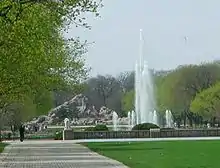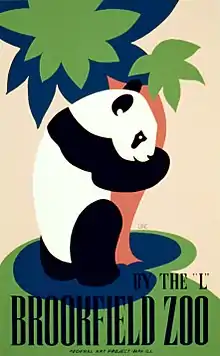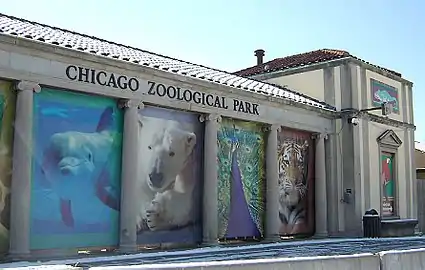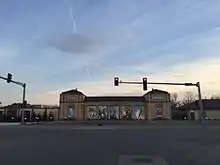Brookfield Zoo
Brookfield Zoo, also known as the Chicago Zoological Park,[2][3] is a zoo located in the Chicago suburb of Brookfield, Illinois. It houses around 450 species of animals in an area of 216 acres (87 ha). It opened on July 1, 1934, and quickly gained international recognition for using moats and ditches instead of cages to separate animals from visitors and from other animals. The zoo was also the first in America to exhibit giant pandas, one of which (Su Lin[4]) has been taxidermied and put on display in Chicago's Field Museum of Natural History. In 1960, Brookfield Zoo built the nation's first fully indoor dolphin exhibit, and in the 1980s, the zoo introduced Tropic World, the first fully indoor rainforest simulation and the then-largest indoor zoo exhibit in the world.
 | |
| Date opened | July 1, 1934 |
|---|---|
| Location | Brookfield, Illinois, United States |
| Coordinates | 41.832671°N 87.833462°W |
| Land area | 216 acres (87 ha) |
| No. of animals | 2300 |
| No. of species | 450 |
| Memberships | AZA[1] |
| Public transit access | BNSF Hollywood |
| Website | www |
The Brookfield Zoo is owned by the Cook County Forest Preserve District and managed by the Chicago Zoological Society. The society sponsors numerous research and conservation efforts globally.
History

In 1919, Edith Rockefeller McCormick donated land she had received from her father as a wedding gift to the Cook County Forest Preserve District for development as a zoological garden. The district added 98 acres (400,000 m2) to that plot and in 1921, the Chicago Zoological Society was established. Serious construction did not begin until 1926, after a zoo tax was approved. Construction slowed during the Great Depression, but regained momentum by late 1931. Construction went on at an increased pace[5] and the zoo opened on July 1, 1934.[6] By the end of September 1934, over one million people had visited the new zoo;[7] the four millionth visitor was just two years later.[8]
The 1950s saw the addition of a veterinary hospital,[9] a children's zoo,[10] and the famous central fountain.[11] The zoo went through a decline in the 1960s until a large bond issue from the Forest Preserve District, close attention to zoo governance, and visitor services saw the zoo recreate itself as one of the nation's best. Tropic World, the then-largest indoor zoo exhibit in the world, was designed by French architect Pierre Venoa and opened in three phases (Africa, Asia, and South America) between 1982 and 1984.[12]
During the zoo's early decades, a narrow-gauge railroad existed, which carried guests around the outer perimeter of the park from the North Gate to the old seven seas Dolphin habitat on the park's south end. Bison lived on a small prairie on the west end of the park and could only been seen from the train, reminiscent of the Old West. The railroad was dismantled in the mid-1980s, although the pathways once used by the train still exist as roads for service vehicles, as does the North Gate station (since converted into a snack stand)

In the early 21st century, the zoo has undergone significant capital upgrades, constructing the Regenstein Wolf Woods, the Hamill Family Play Zoo, butterfly tent, sheltered group catering pavilions, and the largest non-restored, hand-carved, wooden carousel in the United States. Great Bear Wilderness, a new, sprawling habitat, opened in 2010. The interiors of several existing buildings were reconfigured into immersion exhibits, based upon ecosystems rather than by clades; these include the Swamp, the Fragile Rain Forest, Fragile Desert, the Living Coast (the shores of Chile and Peru), the African Savanna and forest, and Australia House.
The zoo's reptile house, the first building to open in 1934, was closed in December 2004 and is being converted into a conservation center which will not display live animals but will detail the zoo's larger conservation mission. The children's zoo was dismantled in early 2013, and a new family-based series of exhibits known as Wild Encounters opened on the site in 2015, which features a red panda, a herd of reindeer, 2 Llamas, bennets wallabys, 22 Nigerian dwarf goats, an African spurred tortoise that's part of the ambassador program that comes out during the spring and summer in the walk about wallaby yard, and a free-flight parakeet aviary.
Because of the expense of constructing Great Bear Wilderness and protests from In Defense of Animals over the deaths of the zoo's African elephants, the Pachyderm House was closed for a year in 2011 for modifications and no longer exhibits Elephants or river hippopotamuses. The building dates back to 1934 and currently houses a pair of Eastern Black Rhinoceroses, and some African spurred tortoises from Africa, 3 of there Darwin Volcano giant tortoises with one still on exhibit at the reptiles and birds building, an outdoor space for their Giant anteaters from tropic world, 2 Lowland tapirs, and 3 new Capybaras from South America. The pachyderm building Also did once have pygmy hippos but their last one passed away.
The Brookfield Zoo is also known for its majestic fountain named after the 26th president of the United States, Theodore Roosevelt. On some days, the fountain's spouting water can reach up to 60 feet high.
The zoo has been closed only five times in its history: On September 14, 2008, after damage from a weekend rainstorm; on February 2, 2011, after a major blizzard; on April 18–19, 2013, after flooding from a severe rainstorm; January 2019 due to below-freezing temperatures; and from March 19 to July 1, 2020, due to the COVID-19 pandemic.
Notable animals
- Ziggy was a 6.5 ton male Asian elephant
- Binti Jua is a female western lowland gorilla
- Cookie, a Major Mitchell's cockatoo, had been part of the zoo's collection since the opening in 1934 until his death in 2016.
Animal exhibits
Australia
- Cherax quadricarinatus
- Australian green tree frog
- Woma python
- Green tree python
- carpet python
- Spiny-tailed monitor
- frilled lizard
- Australian water dragon
- Short-beaked echidna
- Laughing Kookaburra
- Southern hairy-nosed wombat
- Rodrigues fruit bat
- Egyptian fruit bat
- Cape Barren goose
- Bennets wallaby
- Western gray kangaroo
- Emu
Hamill Family's Wild Encounters
Feathers and Scales
- Andean condor
- Bali myna
- Blue poison dart frog
- Chicago garter snake
- Crested wood partridge
- Curl-crested Aracari
- Double-striped thick-knee
- Madagascar spider tortoise
- Gambel's quail
- Greater roadrunner
- Jambu fruit dove
- Purple honeyeater
- Sunbittern
- Sungazer
- Tawny frogmouth
Reptiles and Birds
- Timor python
- Gila monster
- Puna teal
- Green-winged macaw
- Anthony's poison arrow frog
- Reticulated python
- Blue-crowned Motmot
- congo peafowl
- Solomon Islands skink
- Philodryas baroni
Desert's Edge
- African crested porcupine
- Bat-eared fox
- Black-footed cat
- Ocelot
- Meerkat
- Small spotted genet
- Naked mole rat
- White nosed coati
- Chuckwalla
Big Cats
Clouded Leopard Rain Forest
Great Bear Wilderness
Habitat Africa! The Forest
- Black and rufous elephant shrew
- Dwarf crocodile
- Gaboon viper
- Okapi
- Panther chameleon
- Red-billed hornbill
- Red-flanked duiker
- Red river hog
- Royal antelope
- Tomato frog
- Tree pangolin
- White Stork
- Yellow-backed duiker
Habitat Africa! The Savannah
- African wild dog
- Blue-bellied roller
- Dwarf Mongoose
- Emerald starling
- Gerenuk
- Golden-breasted starling
- Kirk's dik-dik
- Klipspringer
- Leopard tortoise
- Namaqua dove
- Nyala
- Paradise whydah
- Reticulated giraffe
- Speckled mousebird
- Taveta golden weaver
- Violaceous turaco
- Violet-backed Starling
Hamill Family Play Zoo
- American kestrel
- Barred tiger salamander
- Boa constrictor
- Cockatiel
- Domestic cat
- Giant African millipede
- Goldfish
- Guinea pig
- Madagascar hissing cockroach
- Mongoose lemur
- Ring-tailed lemur
Hoofed Animals
The Living Coast
- Bar jack
- Lookdown
- Atlantic spadefish
- Kemp's ridley sea turtle
- Cownose ray
- Acropora loripes
- Leaf plate montipora
- Sea goldie
- Paracanthurus
- Green chromis
- Banggai cardinal fish
- Sailfin tang
- Ocellaris clownfish
- Tomato clownfish
- Stichodactyla mertensii
- Rhodactis howesii
- Harlequin tuskfish
- Grey gull
- Humboldt penguin
- Inca tern
- Leopard shark
- Garibaldi (fish)
- Green moray eel
- Halfmoon
- Moon jellyfish
- California sheephead
- Pot-bellied seahorse
- Purple sea urchin
- Rainbow boa constrictor
- Sea apple
- Texas blind cave salamander
Pachyderms
- African spur-thighed tortoise
- capybara
- Eastern black rhinoceros
- Giant anteater
- Galapagos tortoise
- South American tapir
Pinniped Point
Regenstein Wolf Woods
Salt Creek Wilderness
Seven Seas
The Swamp
- Amazon milk frog
- Alligator snapping turtle
- Blue-winged teal
- Eyelash viper
- Great egret
- Green heron
- Little blue heron
- North American river otter
- Orinoco crocodile
- Roseate spoonbill
- Scarlet ibis
- Snowy egret
- White ibis
- Wood duck
Tropic World
- Allen's swamp monkey
- Angolan colobus
- Asian small-clawed otter
- Black-throated laughingthrush
- Bornean orangutan
- Common squirrel monkey
- Cottontop tamarin
- Eastern black-and-white colobus
- Geoffroy's spider monkey
- Giant anteater
- Goeldi's monkey
- Golden lion tamarin
- Hoffmann's two-toed sloth
- Magpie-robin
- Northern white-cheeked gibbon
- Red-cheeked cordon-bleu
- Red-crested turaco
- Red-vented bulbul
- Schmidt's red-tailed guenon
- Violaceous turaco
- Western lowland gorilla
- White-crested laughing thrush
- White-headed buffalo weaver
Dinosaurs Alive!, Series 1 (2009)
- Allosaurus
- Apatosaurus
- Baryonyx
- Deinonychus
- Dilophosaurus
- Metriacanthosaurus
- Omeisaurus
- Parasaurolophus
- Protoceratops
- Pteranodon
- Ruyang Yellow River dinosaur
- Stegosaurus
- Triceratops
- Tyrannosaurus rex
- Yangchuanosaurus
Dinosaurs Alive!, Series 2 (2013)
- Alxasaurus
- Amargasaurus
- Carnotaurus
- Confuciusornis
- Dyoplosaurus
- Gigantoraptor
- Kosmoceratops
- Microraptor
- Olorotitan
- Pachycephalosaurus
- Shantungosaurus
- Sinosauropteryx
- Spinosaurus
- Styracosaurus
- Tuojiangosaurus
- Velociraptor
Dinosaurs Alive!, Series 3 (2017)
Dinosaurs Alive!, Series 4 (2020)
- Argentinosaurus
- Azhdarcho
- Cryolophosaurus
- Datousaurus
- Gallimimus
- Maiasaura
- Majungasaurus
- Pentaceratops
- Rapetosaurus
- Shunosaurus
- Tarchia
- Tenontosaurus
- Troodon
Dinosaurs Alive!, Series 5 (2021)
Dragons! (2017)
Ice Age Giants! (2022)
TBA.
Xtreme BUGS! (2012)
- African fat-tailed scorpion
- Army ant
- Asian giant hornet
- Atlas moth
- Black corsair
- Brown marmorated stink bug
- Chinese earth tiger
- European honeybee
- Giant vinegaroon
- Golden orb weaver
- Hines emerald dragonfly
- Leaf-cutter ant
- Madagascar hissing cockroach
- Monarch butterfly
- Orchid mantis
- Periodic cicada
- Peruvian giant centipede
- Praying mantis
- Red-eyed devil katydid
- Red imported fire ant
- Seven-spotted ladybug
- Siafu
Former holdings
- African bush elephant
- Asian elephant
- African forest elephant
- Hippopotamus
- Pygmy hippopotamus
- Aardvark
- Blue Wildebeest
- American flamingo
- Sable antelope
- Greater kudu
- Bongo
- Mandrill
- Chimpanzee
- Saddle-billed stork
- Hamadryas Baboon
- Takin
- African forest buffalo
- Marabou stork
- Spotted Hyena
- Common ostrich
- Cheetah
- Warthog
- Keel-billed toucan
- Holstein Friesian cattle
- Donkey
- Sheep
- Pot-bellied Pig
- Miniature Horse
- Chicken
- Giant panda
- Spectacled bear
- Asiatic black bear
- American black bear
- Fur Seal
- Harbor seal
- Elephant seal
- Walrus
- White rhinoceros
- Indian rhinoceros
- Water chevrotain
- Siberian ibex
- Dalls sheep
- Rocky mountain goat
- Musk ox
- European bison
- Red hartebeest
- Cokes hartebeest
- Blesbok
- Cattle
- Horse
- Waterbuck
- Topi
- White eared kob
- Nile lechwe
- Beisa oryx
- Scimitar horned oryx
- Sitatunga
- Lesser kudu
- Pere David's deer
- Mule deer
- White-tailed deer
- Guinea Baboon
- Domestic Goose
Notable staff
Chicago cartoonist John T. McCutcheon was the president of the Chicago Zoological Society from 1921 until 1948 and oversaw the zoo's construction, opening and its early years, including helping it through the war years, when the zoo saw a decrease in attendance.
Grace Olive Wiley briefly worked as a reptile curator at the zoo in 1935.[13]
George B. Rabb was the director of Brookfield Zoo from 1976 until 2003, having originally worked as a researcher and an assistant to the director.
Conservation programs
- The Brookfield Zoo has a conservation project in Punta San Juan, Peru. Disney World partnered with zoo by giving a $25,000 grant assigned specifically to the work in Punta San Juan, Peru, which helped the Chicago Zoological Society conservationists gain clearance into the highly restricted and protected area. The CZS has hired multiple people that already worked for the reserve to help build a conservation research team. Samples are taken from wildlife such as South American sea lions, Inca terns, Peruvian boobys, Guanay cormorants, and the endangered Humboldt penguins. The team uses the information they gathered to research the environment, observe the species, and monitor populations. Project results further knowledge about the ocean and help save endangered species. Team members also continuously have groups of children, of varying ages, go out to clean up garbage that accumulates on the beaches of Punta San Juan from the Pacific Ocean.[14]
Economics
In 2014, revenue of the Brookfield Zoo was made up by $26.6 million from admissions and guest services, $15.2 million from taxes, $11.5 million from membership dues, $11.5 million from contributions, sponsorships, and net assets released, and $1.2 million from investments and other income. Expenses in 2014 included $15.7 million for admissions and guest services, $15 million for animal collections and conservation programs, $10.7 million for care of buildings and grounds, $7.9 million for management and general, $5.9 million for public education and communications, $3.8 million for marketing and public relations, $3.4 million for fundraising, and $1.4 million for membership. Revenue totaled $66 million and spending totaled $63.8 million during 2014.[15]

In 2010, Governor Pat Quinn granted the Brookfield Zoo $15.6 million to aid repairing and remodeling many parts of the zoo. This included updating the north entrance to the zoo on 31st Street and Golfview Avenue.[16]
The CZS has hosted several fundraising events, Wines in the Wild and Wild Wild Whirl, where they collected various donations ranging in totals from $130,000 to $1.5 million.[17][18]
A total of 808 volunteers help the zoo with 74,401 community service hours which equates to $1.86 million of work.[15]
Economic movement approaches $150 million, 2,000 jobs, 580 volunteers, and 2.2 million visitors every year.[19]
Gallery
 Ibex Island - demolished
Ibex Island - demolished Siberian ibex - in old habitat
Siberian ibex - in old habitat Habitat Africa - Giraffe Enclosure
Habitat Africa - Giraffe Enclosure Giraffe Overlook 1
Giraffe Overlook 1
Notes
- "Currently Accredited Zoos and Aquariums". aza.org. AZA. Retrieved 20 August 2011.
- "Brookfield Zoo (Chicago Zoological Park)". Encyclopedia of Chicago. Chicago Historical Society.
- "Brookfield Zoo". Encyclopædia Britannica.
- "Pandas Galore". Time. 1938-04-11. Archived from the original on August 26, 2010.
- "50 CWA Workers Rush Construction on Brookfield Zoo". Chicago Daily Tribune. 1933-12-31. p. 6.
- Kelley, Katherine (1934-01-18). "Brookfield Zoo Will Be Ready to Open July 1". Chicago Daily Tribune. p. 20.
- "Total of Brookfield Zoo Visitors Exceeds Million". Chicago Daily Tribune. 1934-09-29. p. 5.
- "Zoo's 4,000,000th Visitor". Chicago Daily Tribune. 1936-09-08. p. 1.
Phyllis Guren of Bemidji, Minn., the 4000000th visitor to the Brookfield zoo, with bicycle which was her reward.
- Hutchinson, Louise (1953-01-15). "Brookfield Zoo Hospital Gives Succor to Sick". Chicago Daily Tribune. p. S9.
- Hutchinson, Louise (1953-07-19). "2 Kinds of Kids Ready for New Brookfield Zoo". Chicago Daily Tribune. p. NW6.
- "Dedicate Theodore Roosevelt Fountain at Zoo". Chicago Daily Tribune. 1954-05-15. p. B7.
- Presecky, William (1983-05-11). "Brookfield Zoo's Tropic World opens doorway to Asia". Chicago Tribune. p. SD3.
- "Miscellany: Apples". Time. 1935-09-30. Archived from the original on December 22, 2011.
- Gregory, Ted. "Brookfield Zoo's Quiet Crusade: Saving Wildlife on the Peruvian Coast." Chicago Tribune, December 22, 2015. Accessed February 21, 2016. http://www.chicagotribune.com/news/globalcity/ct-brookfield-zoo-peru-marine-conservation-20151222-story.html.
- Chicago Zoological Society. "2014 Annual Report." N.p., n.d. Web. 10 Apr. 2016. https://www.czs.org/getmedia/48420feb-fb4d-489c-81e5-16c88c67f214/2014-CZS-Annual-Report.aspx Archived 2015-10-20 at the Wayback Machine
- Smith, Katie. "Gov. Quinn Gives $15.6 Million to Brookfield Zoo, Which Is Criticized by Animal Rights Groups for Its Elephant Conditions." Gov. Quinn Gives $15.6 Million to Brookfield Zoo, Which Is Criticized by Animal Rights Groups for Its Elephant Conditions. January 12, 2010. Accessed February 28, 2016. http://newsarchive.medill.northwestern.edu/chicago/news-153397-print.html {{Webarchive|url=https://web.archive.org/web/20160513025935/http://newsarchive.medill.northwestern.edu/chicago/news-153397-print.html |date=2016-05-13 }}.
- Litas, Lee A. ""Wines in the Wild" Raises $130,000 for Brookfield Zoo." Western Springs, The Doing. Chicago Tribune, 23 Nov. 2015. Web. 11 Feb. 2016. <http://www.chicagotribune.com/suburbs/western-springs/lifestyles/ct-dhd-faces-brookwine-tl-1203-20151120-story.html>.
- Pioneer Press. "Brookfield Zoo Celebrates a Wild Wild Whirl." Western Springs, The Doing. Chicago Tribune, 7 May 2015. Web. 11 Feb. 2016. <http://www.chicagotribune.com/suburbs/western-springs/lifestyles/ct-dhd-trend-zoowhirl-tl-0507-20150507-story.html>.
- "Chicago Zoological Society - Economic Impact." Chicago Zoological Society - Economic Impact. 2014. Accessed February 27, 2016. https://www.czs.org/Chicago-Zoological-Society/Community-Impact/Economic-Impact.